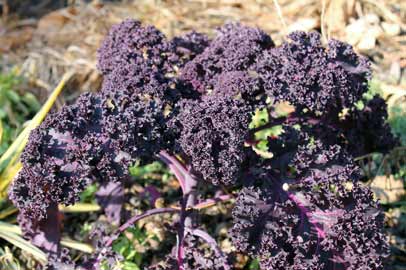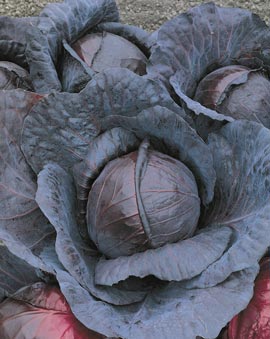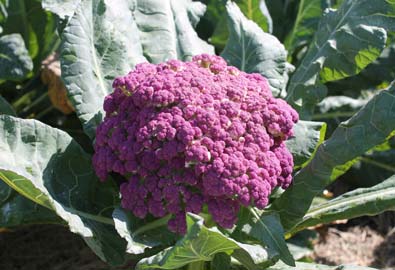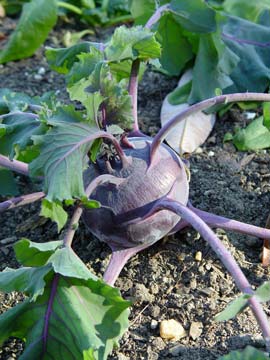Trying to eat healthier? Eat purple.
 'Redbor' is a variety of kale that matures from burgundy to deep purple in fall.
'Redbor' is a variety of kale that matures from burgundy to deep purple in fall.
George Weigel
The same plant pigments that give burgundy and purple color to plant leaves, roots and fruits also act as antioxidants when eaten. That’s why dieticians often advise eating a "rainbow" of antioxidant-rich fruits and vegetables for high nutritional value and possible health benefits, such as lowering blood pressure, fighting cancer and aiding brain health.
The anthocyanins that make edibles purple are particularly hot lately because they add color and beauty to the garden as well.
Here are 10 purple performers to try in this year’s garden:
Kale. This frost tough leafy crop is a nutritional powerhouse even in its green form, but 'Redbor' matures from burgundy to deep purple in fall to a striking ornamental plant. 'Scarlet' and 'Darkibor' are two other good dark-leafed ones.
Carrots. Some have purple skins, others are purple throughout. Look for 'Purple Haze,' 'Purplesnax,' 'Purple Dragon,' 'Purple Sun,' 'Deep Purple,' 'Purple 68,' and 'Black Nebula.'
 'Red Express' is a mid-sized cabbage that grows purple leaves.
'Red Express' is a mid-sized cabbage that grows purple leaves.
George Weigel
Cabbage. Both heirlooms and newer hybrids produce tight balls of rosy-purple leaves, including 'Red Express,' 'Ruby Perfection,' 'Primero,' 'Ruby Ball,' 'Omero,' and 'Mammoth Red Rock.'
Broccoli. Varieties are available that produce both loose sprouts and larger heads with buds and stems of lavender or purple, including 'Purple Crown,' 'Summer Purple,' 'Purple Peacock' and 'Miranda.'
 Cauliflower now comes in purple varieties in addition to creamy-white and soft orange.
Cauliflower now comes in purple varieties in addition to creamy-white and soft orange.
George Weigel
Cauliflower. 'Purple of Sicily' is an heirloom light-purple cauliflower, while 'Graffiti' and 'Depurple' are two newer introductions that produce rich purple heads.
 Purple kohlrabi looks like an alien vegetable with its antennae-like leaves jutting out around the edible ball’s perimeter.
Purple kohlrabi looks like an alien vegetable with its antennae-like leaves jutting out around the edible ball’s perimeter.
George Weigel
Kohlrabi. This little-known cabbage-family plant produces crunchy orbs low to the ground that have leaves jutting out around the perimeter. Most are green or creamy-white, but 'Kolibri,' 'Azur Star' and 'Purple Vienna' are purple varieties.
Leafy crops. Many salad greens come in burgundy to purple versions, such as the particularly cold-tough red orach and red mustard; the red stalks and leaves of several chard varieties; Asian greens such 'Rosie,' 'Red Rain' and 'Red Pac' pak choi, and leaf lettuces such as 'Outredgeous,' 'Red Sails,' 'Red Salad Bowl,' 'Lollo Rossa,' 'Ruby Glow' and ‘Vulcan.’
Tomatoes. Many varieties rich in anthocyanins have dark-burgundy, bluish-purple and almost black tints. The new 'Dancing with Smurfs' cherry type is as close to purple as you’ll find, but also try 'Brad’s Atomic Grape,' Artisan™ 'Bumble Bee Purple' and the Indigo® series. Good "blacks" include 'Black Beauty,' 'Cherokee Purple,' 'Black Krim,' 'Paul Robeson' and 'Black Brandywine' (full-sized tomatoes) as well as 'Black Cherry,' 'Purple Russian' and 'Black Pearl' (cherry types).
Peppers. Both sweet bell peppers and hot peppers come with anthocyanin-boosted fruits that ripen purple to black. Bell ones include 'Lilac Bell,' 'Purple Beauty,' 'Purple Star' and 'Tequila,' while hot ones include 'Purple Jalapeno' and 'Purple Lava.'
Beans. Both bush and climbing pole types are available with lavender to dark-purple pods. Purple bush types include 'Amethyst,' 'Royal Burgundy,' 'Velour,' 'Purple Queen' and 'Purple Teepee,' while purple pole types include 'Purple Podded Pole,' 'Purple King' and 'Carminat.'
Maximize performance of all the above vegetables by fertilizing two to three times during the growing season with with a vegetable plant fertilizer.